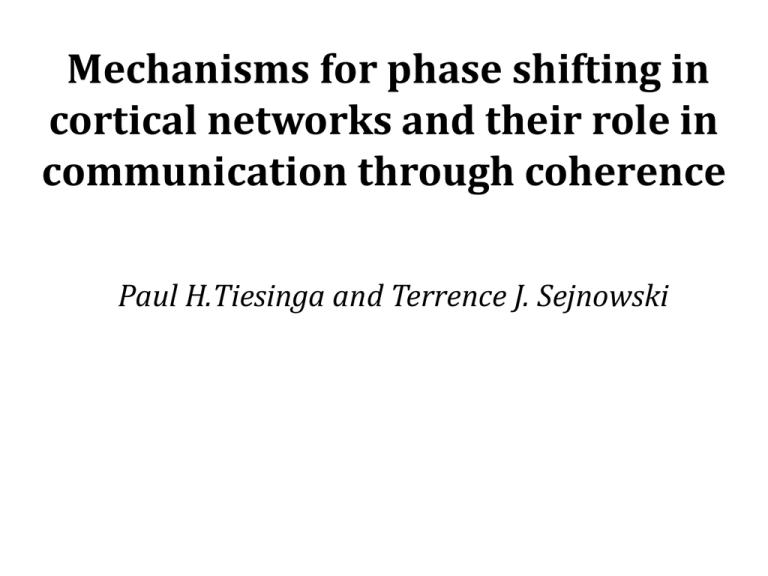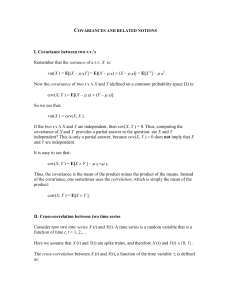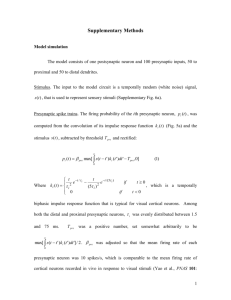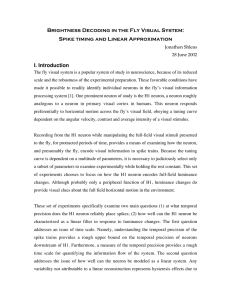JC 17oct2013
advertisement

Mechanisms for phase shifting in cortical networks and their role in communication through coherence Paul H.Tiesinga and Terrence J. Sejnowski Mechanisms for phase shifting in cortical networks and their role in communication through coherence Hubel and Wiesel, 1968 *Carnivora not primate Desimone and Duncan, 1995 Average SFC in the gamma range as a function of stimulus contrast and attention. Communication through neural coherence Chalk et al. 2010 CTC is alternative to CT-FRM, size of the excitatory postsynaptic potential decreases with increasing input rate such that under some conditions, there is no postsynaptic net effect of increased input rate Fries, 2005 Mechanisms for phase shifting in cortical networks and their role in communication through coherence Setup Rule If I volley preceded E volley, the E volley was not effective in driving the postsynaptic neuron, (But) when the E volley preceded the I volley, there was an output spike. Eff. of sensory gating depends on the synchronization Hence, the FR depended on the relative phase of these two inputs, which can be used for stimulus selection. Rate with which E inputs arrive at the neuron for relative phases A: 2 local circuits, both projecting to a 3rd circuit, each comprised of E and I cells with at least a projection from the local I cells to the E cells. Phase event: Mechanisms for phase shifting in cortical networks and their role in communication through coherence Membrane potential of a model neuron Neuron phase locks (1-1.3), FR - constant Standard deviation was equal to the half width of the gray shading Phase shifts occur in response to changes in driving current. Amount of information in the spike phase depends on its mean value, Red cloud – just before the onset of the step; not spherical – skipped spikes Green cloud – Phase lock step reached; (MI maximum) Current increased, MSP decreased Blue cloud - amount of information in the spike phase about the E input was reduced, whereas the IM with the I input was increased fixed number (5) of bins was used for each variable to minimize the bias in entropy estimation Black cloud - neuron is off the phase-locking step In summary, the spike phase shifts due to external activation(depolarizing current)during phase locking and the cycle-to-cycle variation in spike phase can be used to encode information about the input! Mechanisms for phase shifting in cortical networks and their role in communication through coherence 100 I (GABA) 400 E (AMPA) 3 phases can be changed: 1. Local E and I internal phase in SC 2-3. Global phase of S/R Circuit Short E pulses can shift the GPh of a LC PING (pyramidal-interneuron gamma) mechanism Spike time histogram The sum of the latency and E cell recovery period determined the oscillation frequency The latency normalized by the oscillation period is the relative phase between inhibition and excitation Increasing the depolarizing current injected into the I cells reduced the latency (and thus relative phase, Ca), without significantly affecting the oscillation frequency (Ba) The relevant phase difference is that between non-local excitation and local inhibition, which can be changed by altering the global phase of either the sending or receiving local circuit. Size of phase shift depends of time and strength of the pulse! The most effective modulation (largest shift) was obtained when the pulse arrived about 10 ms after the I cell volley. Mechanisms for phase shifting in cortical networks and their role in communication through coherence 21 columns x (84 E + 21 I) P(Conn) ~ diff(pre-, postsynaptic cells) *E conn. more orientation selective than I P/NP: Closest /Farthest 5 (out of 21) preffered orientation Peak in gamma! (Overall pop was sync) P: negative phase – ahead of pop During stimulus NP: positive phase – lagging the overall pop After stimulus Highest FR cells fired ~60° before I cell (or 4ms) Lowest FR cells fired just before I cell A mathematical mechanism for phase shifting Phase locking occurs when neuron is driven by periodic synaptic inputs or current injection and becomes entrained. Const current I - transient = const (intrinsic) rate 𝑓0 𝐼 . + 𝑓𝑑 + A = phase-locking when 𝑓0 𝐼 𝑓𝑑 𝑝 = 𝑞. Not all phase-locked states are equally effective in being phase shifted 2 ways to cycle through p − l states. 1) 𝒇𝒅 − 𝒇𝒊𝒙𝒆𝒅, 𝑰 − 𝒗𝒂𝒓𝒚 2) 𝑓𝑑 −𝑣𝑎𝑟𝑦, 𝐼 − 𝑓𝑖𝑥𝑒𝑑 For the leaky integrate-and-fire neuron the location of phase-locked solutions can be calculated analytically (Coombes and Bressloff, 1999). Mechanisms for phase shifting in cortical networks and their role in communication through coherence Example of phase-locked solutions The effect of noise illustrated by fixing the amplitude and varying the noise strength *D = var(Noise) Width of the phase-locking steps reduced by noise Phase-shifting is observed in vitro and in vivo Spike density was interpreted as the spike rate in the absence of a periodic drive CA1 pyramidal cells in rodent hippocampal. periodic drives are in both theta- (5 Hz) and gamma (40 Hz) range, but phase shifting by increasing the level of depolarizing current is only possible for the theta The range across which can be phaseshifted in vivo does depend on the degree of phase locking. In vivo experiments cannot directly study the mechanism of phase locking because there is no direct measurement of the synaptic inputs that generated the spike train, but the LFP is often used as a surrogate. Because the precision of a neuron is proportional to the time derivative of the membrane potential at spike threshold (Cecchi et al., 2000), a higher amplitude of the sinusoidal current will improve precision and hence the phase-locking strength. Mechanisms for phase shifting in cortical networks and their role in communication through coherence In the primate visual cortex, the phase of spikes relative to oscillations in the local field potential (LFP) in the gamma frequency range (30–80 Hz) can be shifted by stimulus features such as orientation and thus the phase may carry information about stimulus identity. It is possible to use phase shifting for a functional purpose, such as stimulus selection Can be tested directly with optogenetic techniques. The necessary optogenetic manipulation is likely to be feasible in a few years using viral transfection. Han et al. 2009 Hp) Attention can be mediated by CTC via E volleys to I and E cells in networks which are generating the gamma oscillations Han et al. 2009











